Formartine and Buchan Railway
| Formartine and Buchan Railway | |
|---|---|
| Overview | |
| Locale | Scotland |
| Operation | |
| Opened | 23 July 1858 |
| Closed | 3 July 1966 |
| Technical | |
| Line length | 57 mi (92 km) |
| Track gauge | 1,435 mm (4 ft 8 1⁄2 in) |
The Formartine and Buchan Railway was a railway in the north east of Scotland. It was built to link Fraserburgh and Peterhead with Aberdeen. It had a junction with the main line of the Great North of Scotland Railway at Dyce.
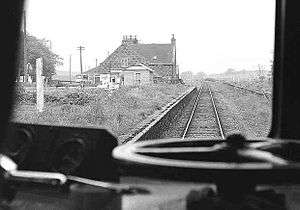
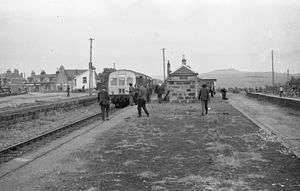
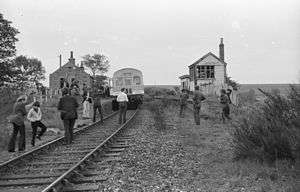
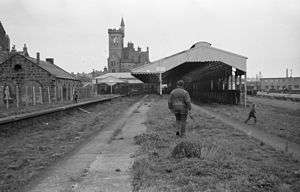
History
The 29 mile long railway from Dyce to Mintlaw opened on 18 July 1861, with the 13 mile section from Maud to Peterhead opening the following year. A 15 mile long section north to Fraserburgh opened on 24 April 1865.[1] The line was built by the Formartine and Buchan Railway Company, which was absorbed by the Great North of Scotland Railway on 30 July 1866. On 2 August 1897, the GNoSR opened a section from Ellon to Boddam. Finally on 1 July 1903 a branch from Fraserburgh to St Combs was constructed. Being partly unfenced this was classified as a light railway and was the last line to be built by the GNoSR. In 1923 the GNoSR was incorporated into the London and North Eastern Railway, which was in turn nationalised on 1 January 1948.
Construction
These lines ran through farming country. Most of the promoters were farmers who wanted a line to transport their produce and livestock to market. The route of this railway was not chosen for engineering or traffic reasons. Since investment was sought[2] from the local landowners their requests for the lines to be placed away from or near to their land was heeded. Indeed, Lord Saltoun invested £6000 but insisted in having a station for his sole use placed close to a road leading to his mansion. This was to be fully signalled and operated at the railway company's expense. His Lordship, his heirs and successors would have the right to have all passenger and goods trains to be stopped on request. A level crossing had to be provided and a gateman employed. Lord Saltoun had the right to sack him if he performed his duties in an uncivil fashion.[2] On the other hand, the company was instructed to keep away from the Haddo Estate. But for the objections of The Earl of Aberdeen several more stations would have been constructed. The plans were changed many times during construction.
Usage
Traffic on this line was very seasonal. When the herring fisheries were active, whale and seal oil was being landed and at harvest time the line was very busy with freight. Several auctioneering businesses set up in Maud to take advantage of the line to transport livestock.[2] In summer there were also many passengers trains for holiday makers; however, away from these seasons the line was very quiet. There was a considerable protest from certain members of the community when the railway company started offering cheap Sunday fares to golfers who were attracted to the new course which had opened at Cruden Bay. It was felt that these golfers were desecrating the sabbath. [2] In winter this area suffers from a considerable amount of snow. In 1960 a train was stuck for 24 hours in a cutting at Newmachar.
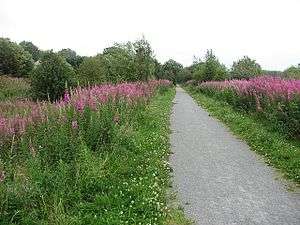
Closure and current use
Passenger services were withdrawn by the Scottish Region of British Railways in 1965 as part of the Beeching cuts. Freight trains continued to operate to Peterhead until 1970 and Fraserburgh until 1979. This was in spite of the fact a considerable amount of freight traffic was being generated by the off shore oil and gas industry. The track was subsequently lifted and much of the route now forms the Formartine and Buchan Way, a long distance footpath and cycle path.
Transport Scotland is considering re-opening sections of this line. The population in the area, largely thanks to the oil and gas industry, has shown a considerable increase since the line was closed. For example, the town of Ellon has 50% more inhabitants than it had in 1979.
Connections to other lines
- Great North of Scotland Railway at Dyce
- Boddam Branch (GNoSR) at Ellon
- St Combs Light Railway (GNoSR) at Fraserburgh
References
Notes
Sources
- Awdry, Christopher (1990). Encyclopaedia of British Railway Companies. Sparkford: Patrick Stephens Ltd. ISBN 1-8526-0049-7. OCLC 19514063.
- Butt, R. V. J. (1995). The Directory of Railway Stations: details every public and private passenger station, halt, platform and stopping place, past and present (1st ed.). Sparkford: Patrick Stephens Ltd. ISBN 1-8526-0508-1. OCLC 60251199.
- Jowett, Alan (March 1989). Jowett's Railway Atlas of Great Britain and Ireland: From Pre-Grouping to the Present Day (1st ed.). Sparkford: Patrick Stephens Ltd. ISBN 1-8526-0086-1. OCLC 22311137.
- Thomas, John (1976) Forgotten Railways Scotland Chapter 10 pages 169 - 171 David & Charles ISBN 0-7153-7185-1
- Thomas, John & Turnock, David (1989) A Regional History of the Railways of Great Britain. Volume 15 North of Scotland Chapter 5 pages 183 & 187 David & Charles ISBN 0-946537-03-8
- Smith, W.A.C. Grampian's Last Day of Steam page 24 Stenlake Publishing Ltd ISBN 1-84033-3391.
- RAILSCOT on Formartine and Buchan Railway